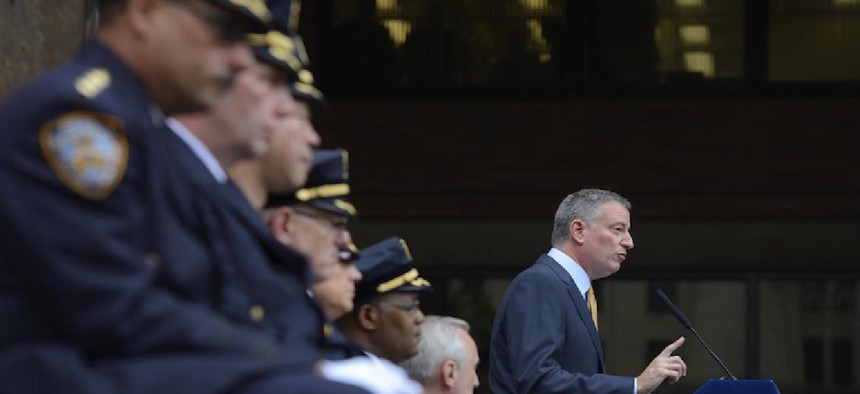When Donald Trump ran for president, he repeatedly told the American public that, if elected, he would focus his efforts on identifying and deporting millions of undocumented immigrants, on surveilling Muslims in the United States and banning them from entering the country and promoting even more aggressive policing against communities of color.
Say what you will about Trump, but at least in this regard, he has been a man of his word.
But here is an important obstacle to the aforementioned agenda: Trump needs more personnel than are available to him at the federal level to fully execute these policies, which involve targeting millions of people nationwide and hundreds of thousands in New York City alone. Accordingly, Trump needs to enlist the help of local law enforcement, and he has been trying to do just that. Case in point: On January 25, President Trump signed an executive order “reviving programs that allow the federal government to work with local and state law enforcement agencies . . . to share information to help track and deport [undocumented immigrants].”
RELATED: Brooklyn's decriminalization success proves Jeff Sessions wrong
New York City Mayor Bill de Blasio has made it clear that the NYPD will not actively assist Trump in pursuing his unlawful and unconstitutional agenda. That’s good, but not good enough. The problem with de Blasio’s approach is that it does not prohibit the NYPD from passively assisting the president by giving the Trump administration access to NYPD surveillance data.
While the NYPD is less than transparent about its use of surveillance technologies, we do know one thing for certain: they use them a lot. The NYPD has publicly admitted to extensively using technologies like automatic license plate readers, surveillance cameras, and “Stingray” cell site simulators that turn people’s cell phones into tracking devices. One critical piece of information the NYPD has not revealed is whether it has entered into any data sharing agreements that would enable the federal government, directly or indirectly, to access its surveillance data. This is an important question because once that data is in the hands of the feds, there is nothing to stop members of the Trump administration, like Attorney General Jeff Sessions, from using it to go after immigrants, Muslims, and other vulnerable communities.
This concern is not science fiction; it is science fact. For example, Brian Hofer, the chair of Oakland’s Privacy Advisory Commission, “has a paper trail” showing that U.S. Immigration and Customs Enforcement (ICE) has been accessing the Oakland Police Department’s automatic license plate reader data and using it to target immigrants. Oakland, like New York, is a sanctuary city.
Does the NYPD have such data sharing agreements with the federal government? Does it share surveillance data with other regional, state, or local entities that then make it available to the feds? The public has no idea. The New York City Council has no idea. The NYPD has the unchecked authority to decide, in secret, when and under what terms it acquires and uses surveillance technologies, and with whom it shares the data. The only way to change that practice is to change the law. That is why the City Council needs to adopt the Public Oversight of Surveillance Technology (POST) Act.
Instead of allowing the NYPD to secretly and unilaterally approve the acquisition and use of surveillance technologies, the POST Act would require the department to provide just enough information to the Council and the public to enable them to engage in a thoughtful discussion about these technologies and to raise any concerns with the mayor and police department. In an attempt to defeat the bill, the NYPD is claiming the POST Act would reveal “state secrets” to terrorists and criminals. A simple reading of the bill reveals that is clearly not the case. In truth, the basic surveillance technology “description and capabilities” information the NYPD would report under the POST Act can already be found using a simple Google search.
RELATED: Glenn Martin on what to do with Rikers
Nothing in the POST Act requires the disclosure of granular, technical specifications about any surveillance tool nor requires the NYPD to provide precise details regarding where and when they employ various technologies. The bill’s additional disclosure requirements merely cover whether the NYPD is using a technology in a lawful and constitutional manner, who is given access to the data, and some basic information about data retention and security.
Seattle, Nashville and California’s Santa Clara County – home of Silicon Valley – have already enacted laws that are similar to the POST Act, but provide their local city Councils with far greater authority than what is under consideration in New York City. States like California and Maine and 17 other U.S. cities are pursuing similar laws. If these surveillance transparency laws compromised public safety, would we be seeing such a groundswell of support from coast to coast? Of course not.
The POST Act would serve to make New Yorkers safer, because it would undermine the Trump administration’s ability to secretly use NYPD surveillance data to target groups the president disfavors.
This is an important gut-check moment for de Blasio and City Council members who have spoken out strongly against the president’s agenda but have had few opportunities to meaningfully hinder his efforts. Ultimately, it will take concrete action – not mere rhetoric – to protect our city’s vulnerable communities. If the mayor and City Council are truly committed to making New York a sanctuary city and to being part of the resistance to the Trump administration’s unlawful and unconstitutional policies, then they must pass the POST Act.
Chad Marlow is the advocacy and policy counsel for the American Civil Liberties Union.


